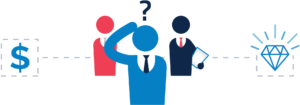Daily Price Decisions: Helping or Hurting Profit Margins?
Daily Price Decisions: Helping or Hurting Profit Margins?
For wholesale distributors and many manufacturers, price setting can be a daily occurrence. A multitude of products combined with a large number of customers makes for a complicated pricing environment.
You add to that complexity when you give your sales team the authority to adjust prices on the fly. Pricing becomes a highly dynamic activity, and the sheer volume of activity makes it difficult for you to determine whether aggregated price decisions are contributing positively or negatively to profit margins.

Transactional Data
Access to transactional data eases the process of measuring price performance. And since most company information & ERP systems can deliver the necessary data to accurately measure price performance, why not tap into that information?
Fundamental data requirements include a baseline data period with item description, price, and units ordered. These are line-item numbers for each individual transaction taken from sales invoices. The baseline is compared to a current time period to measure the difference in price and quantity ordered, which represents the change in price performance when summed across the business. Positive price performance indicates a rise in aggregate pricing and a positive contribution to margins, while negative performance points to a decline and a negative impact on margins.
Data Visualizations
However, data alone doesn’t always provide actionable insights. When we look at price performance, it is more helpful to visualize performance across a variety of scenarios that will lead us to action and results. For example, analyzing by sales region or individual sales rep can provide insights into weak performers who may require redirection or support. Or, analyzing price performance versus cost changes will call out product prices that may be losing pace with rising costs.
We recently identified a product group being ignored by a wholesale distributor that had lost significant margin over time as costs had escalated while prices remained unchanged. The company was focused on higher-volume product groups and was unaware of the narrowing margin gap.
The data required to perform effective analyses can be extensive depending on the type of business. For example, wholesale distributors can have very large numbers of transactions resulting in large datasets. To process the thousands of SKUs and customers, we recommend a cloud-based price and revenue management analytics package that simplifies the measurement, monitoring and forecasting of pricing actions, allowing for midcourse corrections as market conditions change.
Having insight into price performance and its contribution to margin provides a clear path to actions for margin improvement. Having the ability to quickly drill down into specific areas of price performance accelerates the analyzing process and delivers results faster. Still, few companies are taking the initiative to measure price performance, and even fewer are drilling down to identify opportunities for margin lift. Don’t wait. Harness the power of analytical tools that enable you to turn data into intelligence. That intelligence can make all the difference in your quest to boost margins.
Schedule A Free Pricing Consultation
Fill Out The Form Below To Set Up A No Cost, No Obligation Video Conference Call With One Of Our Experienced Pricing Consultants.
"*" indicates required fields
